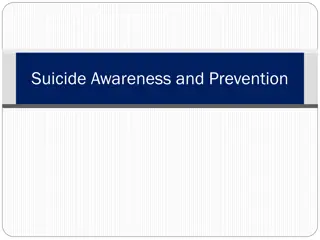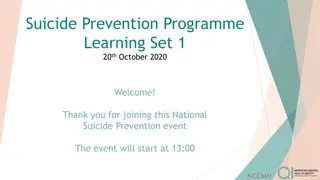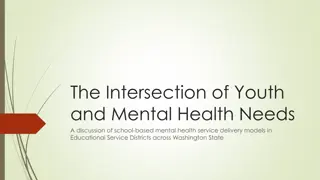Positive Trends in Veteran Suicide Rates Highlighted in 2021 VA Annual Report
New data from the 2021 Department of Veterans Affairs National Veteran Suicide Prevention Annual Report indicates a decrease in the total number of Veteran suicide deaths from 2018 to 2019. The suicide rate among Veterans is higher than that of the non-Veteran U.S. population but showed improvement with a 7.2% decrease in 2019. The report emphasizes the importance of recognizing signs of suicidal thinking and creating a safe home environment to prevent such tragedies. Resources like Suicide Prevention Coordinators are available at VA medical centers to offer support and counseling services to Veterans in need.
Download Presentation

Please find below an Image/Link to download the presentation.
The content on the website is provided AS IS for your information and personal use only. It may not be sold, licensed, or shared on other websites without obtaining consent from the author. Download presentation by click this link. If you encounter any issues during the download, it is possible that the publisher has removed the file from their server.
E N D
Presentation Transcript
VA annual report shows decrease in Veteran suicides WASHINGTON New data included in the Department of Veterans Affairs 2021 National Veteran Suicide Prevention Annual Report notably shows a decrease from 2018 to 2019 in the total number of Veteran suicide deaths, and a decrease in the rate of Veteran suicides per 100,000. than the rate among non-Veteran U.S. adults (16.8 per 100,000). Adjusting for age- and sex-differences, the suicide rate among Veterans in 2019 was 52.3% higher than for non-Veteran U.S. adults. The suicide rate difference between Veterans and the non-Veteran U.S. population was highest in 2017 at 66.3%. From 2018 to 2019, there was a 7.2% overall decrease in the age- and sex- adjusted Veteran suicide mortality rate in 2019, while among non-Veteran U.S. adults, the adjusted suicide mortality rate fell by 1.8%. In 2019, there were 6,261 Veteran suicide deaths, 399 fewer than in 2018. In 2019, the Veteran suicide rate was 31.6 per 100,000, substantially higher
You are Not Alone. Connect with Care Now. Find Local Support on REACH OUT WEBSITE Start your search to find local mental health and suicide prevention resources. Search Resources Connect with your Suicide Prevention Coordinator today Each VA medical center has a Suicide Prevention Coordinator to connect you with the counseling and services needed. Find your local suicide prevention coordinator here. Find Suicide Prevention Coordinator
S Signs igns of suicidal thinking should be recognized. A Ask question of all. sk the most important S. A. V. E. V Validate alidate the Veteran s experience. E Encourage ncourage treatment and E Expedite xpedite getting help.
A Safe Home Environment Can Save Lives Better storage practices of potentially harmful things can help make the home safe and save lives. Thoughts about suicide are often short-lived. A safe home environment can buy you, or a person you re concerned about, time to get help. Safely storing things that can be used to harm oneself, such as firearms firearms and medications medications (opiates; benzos, blood pressure pills), or removing them from your home-even for a short while.
PREVENTS Public Health Approach Overview The P President s R Roadmap to E Empower V Veterans and E End a N National T Tragedy of S Suicide (PREVENTS PREVENTS) is focused on a holistic, all-hands-on-deck approach to suicide prevention. PEVENTS is developing a national Roadmap to change the culture surrounding mental health and suicide prevention through enhanced community integration, prioritized research activities, and implementation strategies that emphasize improved overall health and well-being.
PURPOSE PREVENTS seeks to change the culture surrounding mental health and suicide prevention through enhanced community integration, prioritized research activities, and implementation strategies that emphasize improved overall health and well- being.
GOAL The goal of PREVENTS is to prevent suicide among not just Veterans but all Americans. By adopting a holistic public health approach, PREVENTS is acting on the knowledge that suicide prevention is everyone s business, and that by working together, locally and nationally, we can prevent suicide
WORK PREVENTS is building on the critical successes of suicide prevention pioneers and agencies working with service members and Veterans. PREVENTS is partnering with stakeholders from multiple sectors, including nonprofits, state and local organizations, Fortune 500 companies, and government leaders, to implement best practices to improve health and prevent suicide
Just as suicide has no single cause, no one strategy can end Veteran suicide. VA is using a bundled public health approach that involves multiple sectors, including media and entertainment industries. Research has shown that the way media covers suicide can influence behavior either positively, by encouraging help-seeking, or negatively, by increasing contagion or copycat suicide, which occurs when exposure to suicide or suicidal behaviors contributes to another suicide. The Recommendations for Reporting on Suicide (reportingonsuicide.org) offers guidance to members of the media on covering suicide in a safe and ethical manner. The following are recommendations for developing messages about Veteran suicide. When best practices are applied, messages can correct misconceptions, convey hope, and encourage help-seeking among those at risk for suicide. SAFE MESSAGING BEST PRACTICES
988/Veterans Crisis Line (VCL) VCL provides 24/7 world-class crisis services through phone, chat, and text for all Veterans, Service members, National Guard and Reserve members, and their family members and friends. The recent enactment of the National Suicide Hotline Designation Act (P.L. 116 enactment of the National Suicide Hotline Designation Act (P.L. 116- - 172) established 172) established 988 988 as a national three as a national three- -digit emergency telephone number, replacing the full 1 number, replacing the full 1- -800 800- -273 273- -8255 National Suicide Prevention Lifeline number. Prevention Lifeline number. This full transition must occur by July 16, 2022 2022. Forecasting modeling projects that transitioning to a three-digit code will increase VCL call volume significantly, and VCL is implementing plans to meet this increased demand. Presently, VCL has added 460 new positions to its organizational chart and has begun its hiring process to prepare for this increased demand. The recent digit emergency telephone 8255 National Suicide July 16,
Hannon Act of 2019 (P.L. 116 Hannon Act of 2019 (P.L. 116- -171) 171) The Hannon Act Hannon Act was signed into law on October 17, 2020, providing VA with a significant opportunity to expand suicide prevention efforts across multiple lanes. Notably, Section 201 established the Staff Sergeant Parker Gordon Fox Suicide Prevention Grant Program (SSG Fox SPGP), which enables VA to provide resources for community-based suicide prevention efforts to meet the needs of Veterans and their families through outreach, suicide prevention services and connecting to VA and community resources. This grant program will strengthen local community capacity to conduct outreach to Veterans and families, provide them with suicide prevention services, and connect them to resources within the community and VA to prevent Veteran suicide. SSG Fox SPGP will be a $174 million, three-year community-based grant program that will provide resources to community organizations serving certain Veterans at risk of suicide and their families across the country. Organizations can apply for grants worth up to $750,000 per fiscal year and may apply to renew awards from year to year throughout the length of the program
The Veterans COMPACT Act of 2020 The Veterans COMPACT Act of 2020 (P.L. 116 (P.L. 116- -214) 214) The COMPACT Act COMPACT Act was signed into law by President Trump on December 5, 2020, and enables VA to implement programs, policies, and reports related to transitioning Service members, suicide prevention, and crisis services; mental health education and treatment; and improvement of services for women Veterans. Specific to emergency suicide care, this act will strengthen coordination of care emergency suicide care, this act will strengthen coordination of care between VCL and the Office of Community Care by furnishing emergent between VCL and the Office of Community Care by furnishing emergent care to an eligible individual at a medical facility of the department, pay care to an eligible individual at a medical facility of the department, pay for emergent suicide care provided to an eligible individual at a non for emergent suicide care provided to an eligible individual at a non- - department facility, and reimburse an eligible individual for emergent department facility, and reimburse an eligible individual for emergent suicide care provided to the eligible individual at a non suicide care provided to the eligible individual at a non- -department facility. Specific to department facility.
Suicide Prevention Coordinator Kent Johnson LCSW; BCD; CADC Kent Johnson LCSW; BCD; CADC 1601 Kirkwood Highway Wilmington, DE 302-275-5676** CELL: 302-633-5311** OFFICE VHASPCDE- 460WIMSuicidePreventionTeam@va.gov























